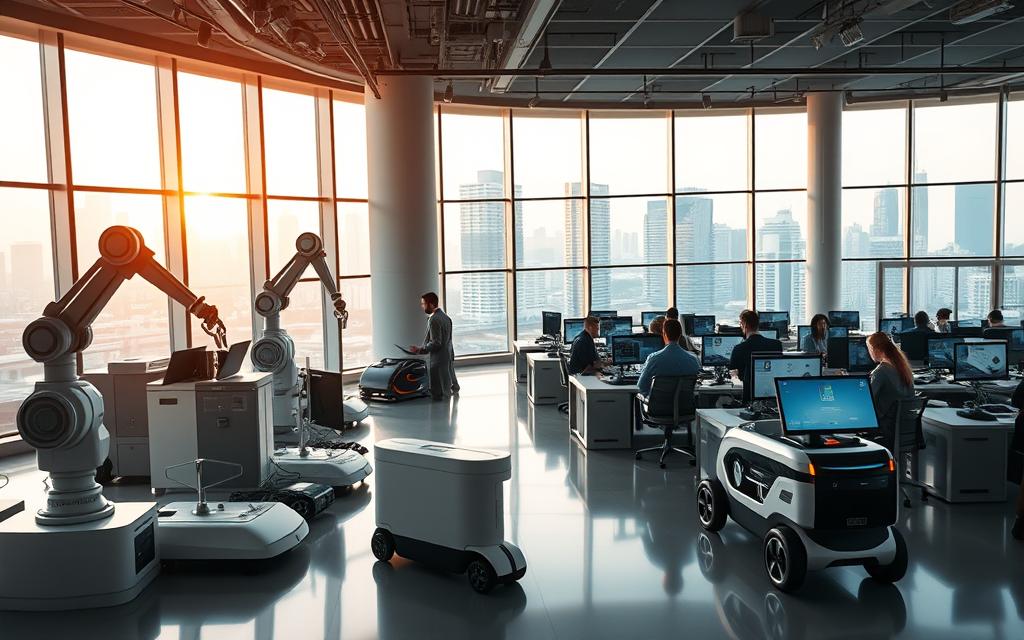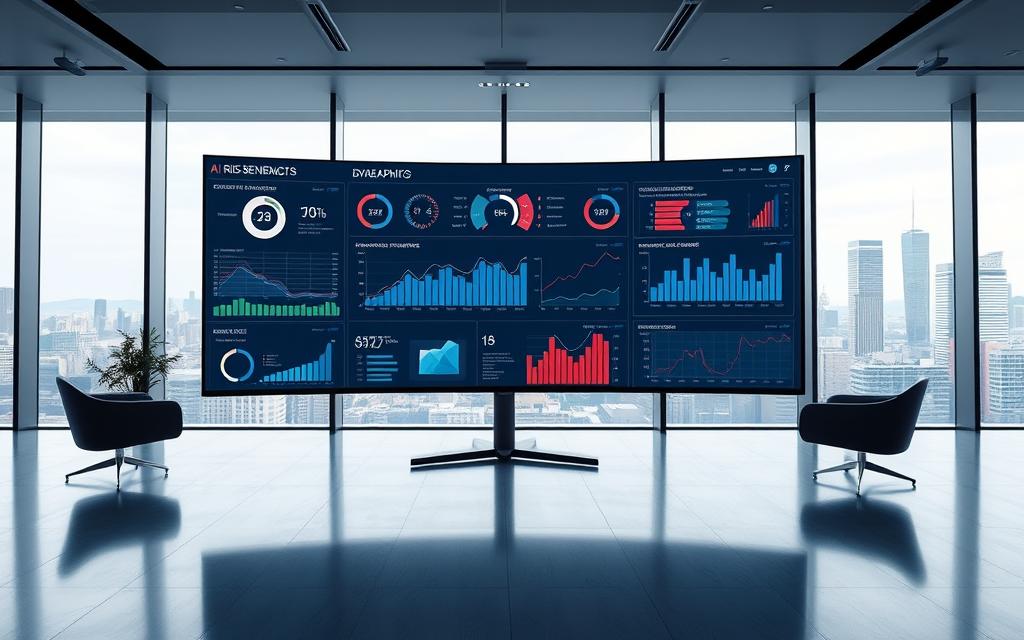Table of Contents
Artificial intelligence is reshaping industries, with 50% of companies leveraging it for multiple functions. From automating processes to enhancing customer experiences, machine learning tools drive efficiency. Leaders like Microsoft and Google rely on these technologies for faster decision-making.
Research shows 79% of strategists view AI as critical for success. McKinsey highlights its potential to automate 60-70% of tasks. Businesses using these solutions see 20% quicker decision cycles, gaining a competitive edge.
Generative AI transforms content creation and product development. IBM Watson improves healthcare diagnostics, while Salesforce’s Einstein optimizes CRM systems. Data-driven insights help companies refine operations and achieve long-term growth.
Improved Decision-Making with AI
Shell’s 18% efficiency boost proves AI’s role in refining operational decisions. By analyzing drilling patterns, machine learning models cut costs and reduced waste. Real-time data analysis now drives strategies across industries, from energy to retail.
Real-Time Data Analysis
AI processes unstructured data—like employee surveys or market reports—in seconds. Deloitte found 59% of executives gain better insights from these tools. For example, IBM Watson scans 200M pages to match cancer patients with clinical trials, achieving 96% accuracy.
“AI reduces human error in forecasting by 90%, delivering cleaner data for critical choices.”
Reduced Human Bias
While humans average a 2% error rate in data tasks, AI slashes it to 0.02%. Retailers using demand prediction saw stockouts drop by 35%. Pattern recognition eliminates guesswork, as shown in AI-driven inventory systems.
From oil rigs to hospitals, AI turns raw data into actionable insights. The result? Faster, unbiased decisions that keep companies ahead of trends.
Increased Efficiency Through Automation
McKinsey reports reveal AI-driven automation saves 400 hours annually per employee. From manufacturing to healthcare, machine learning optimizes processes that once drained resources. These solutions minimize human intervention while maximizing output.

Streamlining Repetitive Tasks
AI handles repetitive tasks like data entry and invoice processing with precision. For example:
- Manufacturers automate 62% of invoices, cutting processing time by 75%.
- Tableau’s automated reporting saves analysts 15 hours weekly.
- HR teams reduce onboarding time by 25% using AI-powered workflows.
Tools like Jupyter Notebooks prototype algorithms faster, accelerating development cycles. UST’s AI testing boosts coding speed by 40%.
Eliminating Human Error
Data entry errors drop dramatically with automation. EHR systems achieve 99.8% accuracy in digitizing medical records. Prescription mistakes fall by 98%, enhancing patient safety.
“AI reduces manual errors by 90%, ensuring reliable data for critical operations.”
In manufacturing, AI-driven changeovers speed production lines by 30%. Accenture’s clients see 25% efficiency gains in HR operations. By replacing guesswork with pattern recognition, businesses achieve consistent results.
Enhanced Customer Experience
Delta Airlines resolves 94% of customer queries via chatbots, setting new service standards. AI transforms interactions, blending speed with personalization. From retail to finance, real-time solutions redefine satisfaction.
24/7 AI-Powered Chatbots
Delta’s chatbots handle 500K+ monthly inquiries, cutting wait times by 40%. Bank of America’s Erica saves $2M monthly while improving resolution rates. Salesforce notes 73% of shoppers expect instant responses—AI delivers.
“Chatbots reduce service costs by 30% while boosting satisfaction scores by 22%.”
*Natural language processing* (NLP) monitors social sentiment, routing complaints faster. Hotels like Marriott use this to slash response delays by half.
Personalized Marketing Campaigns
Sephora’s Virtual Artist lifts basket sizes by 30% through AR makeup trials. Starbucks’ AI-driven drink recommendations drive an 18% sales increase. Hyper-targeted campaigns thrive on predictive analytics.
- Stitch Fix retains 89% of clients via AI styling profiles.
- Nike’s app suggests products based on workout history, lifting conversions by 25%.
These marketing innovations prove AI crafts experiences customers crave. The result? Loyalty and revenue grow in tandem.
Significant Cost Reduction
Walmart’s $1B inventory reduction showcases AI’s financial impact. Machine learning identifies overstock patterns, trimming waste while keeping shelves stocked. These cost-saving solutions extend across industries, from logistics to pharmaceuticals.
Lower Operational Costs
Manufacturers cut energy bills by 18% using AI-powered predictive maintenance. Sensors analyze equipment wear, scheduling repairs before failures occur. UPS saves $400M yearly by optimizing delivery routes with real-time traffic data.
Pharmaceutical companies reduce spoilage by 30% with smart inventory tracking. AI forecasts demand, ensuring perishable goods move faster. Financial teams close books 35% quicker using automated reconciliation tools.
Optimized Resource Allocation
DHL’s AI planning tools free up 20% of warehouse space by stacking smarter. Algorithms calculate ideal storage layouts, maximizing capacity. Construction firms report 22% less equipment downtime thanks to predictive analytics.
“AI-driven anomaly detection cuts audit costs by 40%, delivering cleaner financial records.”
From retail to healthcare, AI transforms resource management. The result? Leaner operations and healthier bottom lines for forward-thinking companies.
Advanced Risk Management
Mastercard blocks $20B in fraud yearly, proving AI’s power in risk prevention. From finance to healthcare, machine learning solutions identify threats faster than humans. Companies leveraging these tools cut losses while boosting compliance.

Predictive Analytics for Risk Assessment
AI predicts equipment failures 14 days in advance, saving manufacturers millions. Real-time data streams alert teams before breakdowns occur. Ford’s supply chain system prevented $300M in losses by flagging supplier risks early.
- Healthcare compliance monitoring reduced HIPAA violations by 40%.
- Disaster recovery planning sped up 75% with AI risk modeling.
- Allianz slashed claims processing time by 65% using NLP.
| Industry | AI Solution | Impact |
|---|---|---|
| Finance | Fraud detection | 99.9% accuracy (PayPal) |
| Insurance | AI adjusters | 3-second claims (Lemonade) |
| Manufacturing | Predictive maintenance | 14-day failure alerts |
Fraud Detection in Finance
PayPal’s deep learning models catch 99.9% of fraudulent transactions. JPMorgan’s COIN saves 360K hours yearly by reviewing contracts for loopholes. Analytics uncover hidden patterns, like unusual login locations or purchase spikes.
“AI reduces false positives in fraud alerts by 50%, streamlining investigations.”
Banks now flag suspicious activity in milliseconds. This technology adapts to new trends, staying ahead of cybercriminals. The result? Safer transactions and higher customer trust.
Driving Innovation and Creativity
Moderna’s 42-day vaccine development highlights AI’s role in transformative innovation. From footwear to pharmaceuticals, machine learning reshapes how products are conceived and refined. Companies leveraging these technologies outpace competitors with faster, smarter solutions.

Generative AI for Product Development
Adidas designed its 4D lattice midsole using generative algorithms, reducing prototyping time by 60%. Airbus applied similar technologies to slash aircraft component costs by 40%. These tools explore thousands of design variations, optimizing for weight, strength, and materials.
“Generative AI cuts R&D cycles by half, turning conceptual sketches into market-ready products.”
- Autodesk’s AI architecture tools shrink design phases from months to weeks.
- L’Oréal develops cosmetic formulas 3x faster with machine learning.
- NASA’s AI-generated spacecraft parts weigh 35% less without sacrificing durability.
AI in Research and Development
Pfizer screened drug compounds 80% faster using predictive models, accelerating lifesaving treatments. Siemens reported a 150% spike in patent filings after integrating AI into ideation workflows. Real-time data analysis identifies promising research paths, minimizing dead ends.
| Industry | AI Application | Outcome |
|---|---|---|
| Healthcare | Drug discovery | 42-day vaccine development (Moderna) |
| Manufacturing | Generative design | 40% cost reduction (Airbus) |
| Consumer Goods | Formula optimization | 3x faster launches (L’Oréal) |
These breakthroughs demonstrate AI’s power to turn trends into tangible advancements. By merging creativity with data, businesses unlock unprecedented growth.
Predictive Analytics for Future-Proofing
Amazon’s 98% demand forecasting accuracy demonstrates how predictive analytics reshapes modern commerce. Companies leveraging these data-driven models anticipate shifts before competitors react. This intelligence transforms inventory, marketing, and equipment maintenance into proactive strategies.

Forecasting Market Trends
Zara slashed unsold inventory by 28% using AI to predict fashion trends. Home Depot achieves 2% regional demand variance accuracy, ensuring shelves stay stocked during peak seasons. These solutions analyze social media, weather patterns, and historical sales to spot emerging opportunities.
- Nestlé grew sales 18% by predicting flavor preferences with machine learning.
- Coca-Cola boosted vending machine revenue 15% through weather-based drink suggestions.
- Unilever enters new markets 40% faster using AI simulations of local buying habits.
“Predictive models reduce forecasting errors by 75%, enabling smarter resource allocation.”
Inventory Management Optimization
Target improved inventory turnover by 22% with AI-powered restocking algorithms. Kroger reduced perishable waste 30% by aligning deliveries with real-time demand signals. These technologies merge point-of-sale data with external factors like holidays or events.
| Company | AI Application | Result |
|---|---|---|
| Chevron | Equipment failure prediction | $500M savings |
| Walmart | Automated replenishment | $1B inventory reduction |
| Starbucks | Demand-based staffing | 12% labor cost drop |
Retailers using AI-driven personalization see 25% higher conversion rates from tailored promotions. The blend of predictive analytics and real-time adjustment creates agile business models ready for tomorrow’s challenges.
Conclusion
Artificial intelligence isn’t just reshaping business—it’s defining success. With 73% of US companies already adopting these solutions, hesitation risks falling behind. Frost & Sullivan projects 89% revenue growth for firms leveraging machine learning.
Key outcomes speak volumes: 25% cost cuts, 35% efficiency gains, and sharper competitive advantage. Emerging trends like edge AI and quantum computing will push boundaries further. Gartner predicts 70% of enterprises will operationalize this technology by 2025.
McKinsey’s $13T economic forecast underscores urgency. Delayed adoption could widen a $4.5T industry gap, per Accenture. The choice is clear—invest in AI now or struggle to catch up later.
Start with pilot programs, upskill teams, and scale smartly. Future-proof your business by turning data into decisions today.
FAQ
How does AI improve decision-making in companies?
AI enhances decision-making by analyzing real-time data, identifying patterns, and reducing human bias. Businesses gain actionable insights for smarter strategies.
Can automation boost productivity in operations?
Yes. Automating repetitive tasks like data entry minimizes errors, speeds up workflows, and frees employees for higher-value work, improving efficiency.
What role does AI play in customer experiences?
AI-powered chatbots provide 24/7 support, while personalized marketing campaigns tailor recommendations, increasing engagement and satisfaction.
Does AI help reduce business costs?
Absolutely. Optimizing resource allocation and lowering operational expenses through intelligent automation cuts costs significantly.
How does AI enhance risk management?
Predictive analytics forecast potential risks, while machine learning detects fraud in financial transactions, ensuring proactive mitigation.
Can AI drive innovation in product development?
Generative AI accelerates R&D by simulating designs and testing concepts, fostering creativity and faster time-to-market.
Why is predictive analytics vital for businesses?
It forecasts market trends and optimizes inventory, helping companies stay competitive and future-proof their operations.









